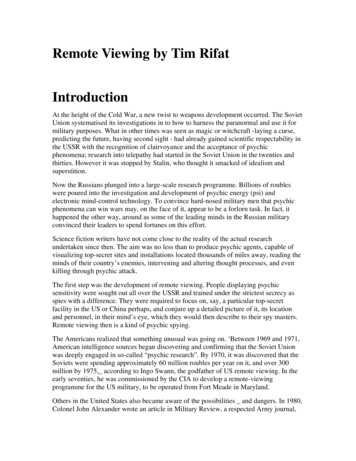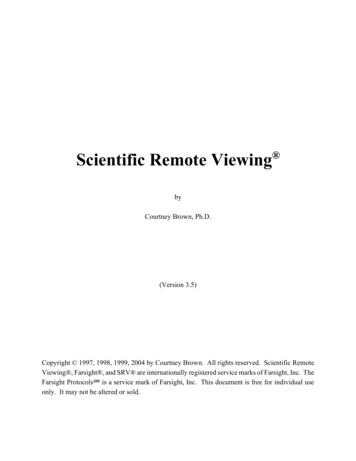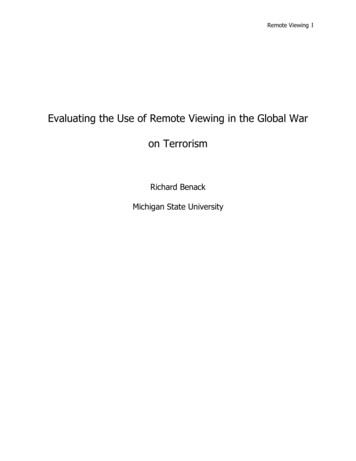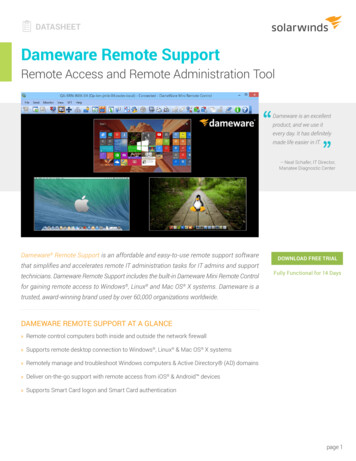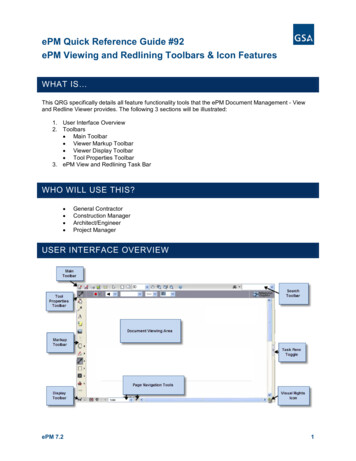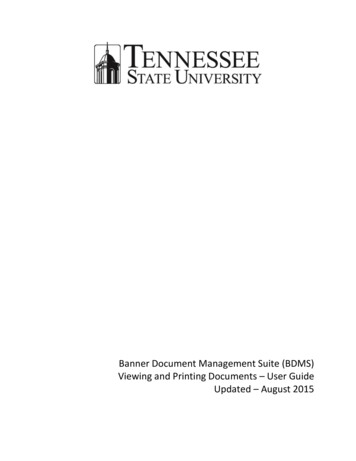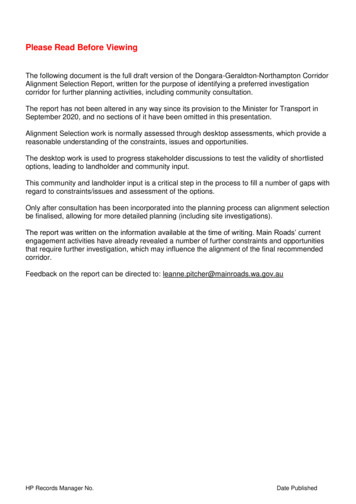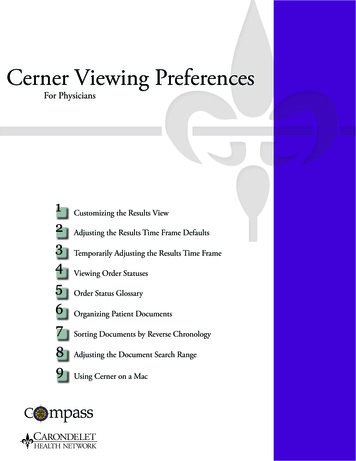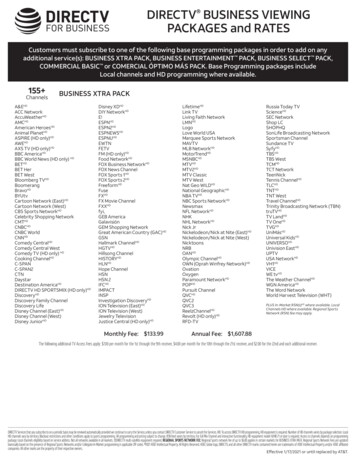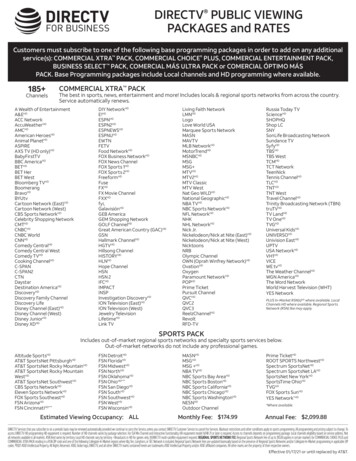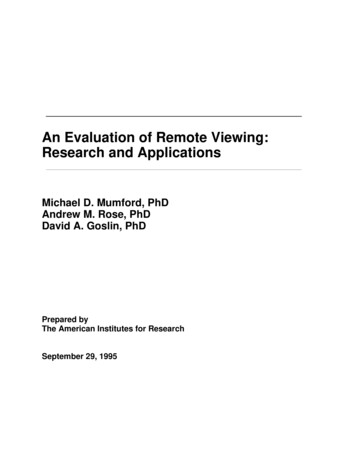
Transcription
An Evaluation of Remote Viewing:Research and ApplicationsMichael D. Mumford, PhDAndrew M. Rose, PhDDavid A. Goslin, PhDPrepared byThe American Institutes for ResearchSeptember 29, 1995
Executive SummaryExecutive SummaryStudies of paranormal phenomena have nearly always been associated with controversy.Despite the controversy concerning their nature and existence, many individuals and organizationscontinue to be avidly interested in these phenomena. The intelligence community is no exception:beginning in the 1970s, it has conducted a program intended to investigate the application of oneparanormal phenomenon—remote viewing, or the ability to describe locations one has not visited.Conceptually, remote viewing would seem to have tremendous potential utility for theintelligence community. Accordingly, a three-component program involving basic research,operations, and foreign assessment has been in place for some time. Prior to transferring thisprogram to a new sponsoring organization within the intelligence community, a thorough programreview was initiated.The part of the program review conducted by the American Institutes for Research (AIR),a nonprofit, private research organization, consisted of two main components. The firstcomponent was a review of the research program. The second component was a review of theoperational application of the remote viewing phenomenon in intelligence gathering. Evaluation ofthe foreign assessment component of the program was not within the scope of the present effort.Research EvaluationTo evaluate the research program, a "blue ribbon" panel was assembled. The panelincluded two noted experts in the area of parapsychology: Dr . Jessica Utts, a Professor ofAmerican Institutes for ResearchE-1
Executive SummaryStatistics at the University of California/Davis, and Dr. Raymond Hyman, a Professor ofPsychology at the University of Oregon. In addition to their extensive credentials, they wereselected to represent both sides of the paranormal controversy: Dr. Utts has published articles thatview paranormal interpretations positively, while Dr. Hyman was selected to represent a moreskeptical position. Both, however, are viewed as fair and open-minded scientists. In addition tothese experts, this panel included two Senior Scientists from AIR; both have recognizedmethodological expertise, and both had no prior background in parapsychological research. Theywere included in the review panel to provide an unbiased methodological perspective. In addition,Dr. Lincoln Moses, an Emeritus Professor at Stanford University, provided statistical advice, whileDr. David A. Goslin, President of AIR, served as coordinator of the research effort.Panel members were asked to review all laboratory experiments and meta-analytic reviewsconducted as part of the research program; this consisted of approximately 80 separatepublications, many of which are summary reports of multiple experiments. In the course of thisreview, special attention was given to those studies that (a) provided the strongest evidence forthe remote viewing phenomenon, and ( b) represented new experiments controlling formethodological artifacts identified in earlier reviews. Separate written reviews were prepared byDr. Utts and Dr. Hyman. They exchanged reviews with other panel members who then tried toreach a consensus.In the typical remote viewing experiment in the laboratory, a remote viewer is asked tovisualize a place, location, or object being viewed by a "beacon" or sender. A judge then examinesthe viewer's report and determines if this report matches the target or, alternatively, a set ofdecoys. In most recent laboratory experiments reviewed for the present evaluation, NationalGeographic photographs provided the target pool. If the viewer's reports match the target, asopposed to the decoys, a hit is said to have occurred. Alternatively, accuracy of a set of remoteviewing reports is assessed by rank-ordering the similarity of each remote viewing report to eachphotograph in the target set (usually five photographs). A better-than-chance score is presumed torepresent the occurrence of the paranormal phenomenon of remote viewing, since the remoteviewers had not seen the photographs they had described (or did not know which photographshad been randomly selected for a particular remote viewing trial).American Institutes for ResearchE-2
Executive SummaryIn evaluating the various laboratory studies conducted to date, the reviewers reached thefollowing conclusions: A statistically significant laboratory effort has been demonstrated in the sense thathits occur more often than chance. It is unclear whether the observed effects can unambiguously be attributed to theparanormal ability of the remote viewers as opposed to characteristics of the judgesor of the target or some other characteristic of the methods used. Use of the sameremote viewers, the same judge, and the same target photographs makes itimpossible to identify their independent effects. Evidence has not been provided that clearly demonstrates that the causes of hits aredue to the operation of paranormal phenomena; the laboratory experiments have notidentified the origins or nature of the remote viewing phenomenon, if, indeed, itexists at all.Operational EvaluationThe second component of the program involved the use of remote viewing in gatheringintelligence information. Here, representatives of various intelligence groups—"end users" ofintelligence information—presented targets to remote viewers, who were asked to describe thetarget. Typically, the remote viewers described the results of their experiences in written reports,which were forwarded to the end users for evaluation and, if warranted, action.To assess the operational value of remote viewing in intelligence gathering, amultifaceted evaluation strategy was employed. First, the relevant research literature wasreviewed to identify whether the conditions applying during intelligence gathering wouldreasonably permit application of the remote viewing paradigm. Second, members of three groupsinvolved in the program were interviewed: (1) end users of the information; (2) the remoteviewers providing the reports, and (3) the program manager. Third, feedback informationAmerican Institutes for ResearchE-3
Executive Summaryobtained from end user judgments of the accuracy and value of the remote viewing reports wereassessed.This multifaceted evaluation effort led to the following conclusions: The conditions under which the remote viewing phenomenon is observed inlaboratory settings do not apply in intelligence gathering situations. For example,viewers cannot be provided with feedback and targets may not display thecharacteristics needed to produce hits. The end users indicating that, although some accuracy was observed with regard tobroad background characteristics, the remote viewing reports failed to produce theconcrete, specific information valued in intelligence gathering. The information provided was inconsistent, inaccurate with regard to specifics, andrequired substantial subjective interpretation. In no case had the information provided ever been used to guide intelligenceoperations. Thus, Remote viewing failed to produce actionable intelligence.ConclusionsThe foregoing observations provide a compelling argument against continuation of theprogram within the intelligence community. Even though a statistically significant effect has beenobserved in the laboratory, it remains unclear whether the existence of a paranormal phenomenon,remote viewing, has been demonstrated. The laboratory studies do not provide evidence regardingthe origins or nature of the phenomenon, assuming it exists, nor do they address an importantmethodological issue of inter-judge reliability.Further, even if it could be demonstrated unequivocally that a paranormal phenomenonoccurs under the conditions present in the laboratory paradigm, these conditions have limitedAmerican Institutes for ResearchE-4
Executive Summaryapplicability and utility for intelligence gathering operations. For example, the nature of theremote viewing targets are vastly dissimilar, as are the specific tasks required of the remoteviewers. Most importantly, the information provided by remote viewing is vague and ambiguous,making it difficult, if not impossible, for the technique to yield information of sufficient quality andaccuracy of information for actionable intelligence. Thus, we conclude that continued use ofremote viewing in intelligence gathering operations is not warranted.American Institutes for ResearchE-5
Chapter One: Background and HistoryChapter One: Background and HistoryIn their continuing quest to improve effectiveness, many organizations have soughttechniques that might be used to enhance performance. For the most part, the candidatetechniques come from rather traditional lines of inquiry stressing interventions such as selection,training, and performance appraisal. However, some other, more controversial performanceenhancement techniques have also been suggested. These techniques range from implicit learningand mental rehearsal to the enhancement of paranormal abilities.In the mid-1980s, at the request of the Army Research Institute, the National ResearchCouncil of the National Academy of Sciences established a blue ribbon panel charged withevaluating the evidence bearing on the effectiveness of a wide variety of techniques for enhancinghuman performance. This review was conducted under the overall direction of David A. Goslin,then Executive Director of the Commission on Behavioral and Social Sciences and Education(CBASSE), and now President of the American Institutes for Research (AIR). The review panel'sreport, Enhancing Human Performance: Issues, Theories, and Techniques, was published by theNational Academy Press in 1988 and summarized by Swets and Bjork (1990). They noted thatalthough the panel found some support for certain alternative performance enhancementtechniques—for example, guided imagery—little or no support was found for the usefulness ofmany other techniques, such as learning during sleep and remote viewing.Although the findings of the National Research Council (NRC) were predominantlynegative with regard to a range of paranormal phenomena, work on remote viewing has continuedunder the auspices of various government programs. Since 1986, perhaps 50 to 100 additionalstudies of remote viewing have been conducted. At least some of these studies representAmerican Institutes for Research1-1
Chapter One: Background and Historysignificant attempts to address the methodological problems noted in the review conducted by theNRC panel.At the request of Congress, the Central Intelligence Agency (CIA) is consideringassuming responsibility for this the remote viewing program. As part of its decision-makingprocess, the CIA was asked to evaluate the research conducted since the NRC report. Thisevaluation was intended to determine: (a) whether this research has any long-term practical valuefor the intelligence community, and (b) if it does, what changes should be made in methods andapproach to enhance the value of remote viewing research. To achieve these goals, the CIAcontracted with the American Institutes for Research to supervise and conduct the evaluation.This report contains the results of our evaluation.Before presenting our results, we begin by presenting a brief overview of the remoteviewing phenomenon and a short history of the applied program that involves remote viewing.Remote ViewingAlthough parapsychological research has a long history, studies of "remote viewing"—also referred to as a form of "anomalous cognition"—as a unique manifestation of psychicfunctioning began in the 1970s. In its simplest form, a typical remote viewing study during thisearly period of investigation consisted of the following: A person, referred to as a "beacon" or"sender," travels to a series of remote sites. The remote viewer, a person who putatively has theparapsychological ability, is asked to describe the locations of the beacon. Typically, theselocation descriptions include drawings and a verbal description of the location. Subsequently, ajudge evaluates this description by rank ordering the set of locations against the descriptions. Ifthe judge finds that the viewer's description most closely matched the actual location of thesender, a hit is said to have occurred. If hits occur more often than chance, or if the assignedranks are more accurate than a random assignment, one might argue that a psychic phenomenonhas been observed: the viewer has described a location not visited during the session. Thisphenomenon has been studied by various investigators throughout the intervening period, usingseveral variants of this basic paradigm.American Institutes for Research1-2
Chapter One: Background and HistoryIf certain people (or all people to a greater or lesser extent, as has been proposed bysome investigators) possess the ability to see and describe target locations they have not visited,this ability might prove of great value to the intelligence community. As an adjunct method togathering intelligence, people who possess this ability could be asked to describe variousintelligence targets. This information, especially if considered credible and reliable, couldsupplement and enhance more time-consuming and perhaps dangerous methods for collectingdata. Although certain (perhaps unwarranted) assumptions, such as the availability of a sender, areimplicit in this argument, the possibility of gathering intelligence through this mechanism hasprovided the major impetus for government interest in remote viewing.Remote viewing was and continues to be a controversial phenomenon. Early research onremote viewing was plagued by a number of statistical and methodological flaws.1 One statisticalflaw found in early studies of remote viewing, for example, was due to failure to control fo
remote viewing targets are vastly dissimilar, as are the specific tasks required of the remote viewers. Most importantly, the information provided by remote viewing is vague and ambiguous, making it difficult, if not impossible, for the technique to yield information of sufficient quality and accuracy of information for actionable intelligence. Thus, we conclude that continued use of remote .
